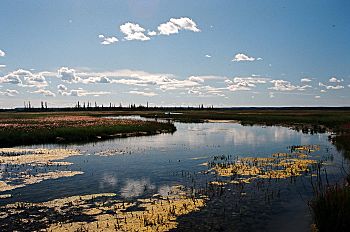Salt River (Canada) facts for kids
Quick facts for kids Salt River |
|
|---|---|
 |
|
| Country | Canada |
| Provinces | Alberta and Northwest Territories |
| Physical characteristics | |
| Main source | McNeil Lake Alberta 59°32′33.9″N 112°27′38.7″W / 59.542750°N 112.460750°W |
| River mouth | Slave River Salt River settlement, Northwest Territories 60°06′39.2″N 112°13′54″W / 60.110889°N 112.23167°W |
Salt River is a river in Canada whose source is McNeil Lake in Wood Buffalo National Park in northern Alberta. It enters the Slave River north of Fort Smith, Northwest Territories.
The main tributaries are Brine Creek (mouth coordinates 59°56′46.7″N 112°16′14.7″W / 59.946306°N 112.270750°W) and Loop Creek (mouth coordinates 59°39′31.2″N 111°55′14.5″W / 59.658667°N 111.920694°W).
Salt River settlement
At the mouth of the river is a village known as Salt River. It was settled in the latter part of the 18th century. Francois Beaulieu (1771–1872) was its most notable resident. A Roman Catholic mission was in the village from 1850 until 1876 when it moved to Fort Smith.
Salt deposits were collected from the banks during the fur trade era.

All content from Kiddle encyclopedia articles (including the article images and facts) can be freely used under Attribution-ShareAlike license, unless stated otherwise. Cite this article:
Salt River (Canada) Facts for Kids. Kiddle Encyclopedia.
